The Drover’s Wife: Gothic Fiction in an Australian Context
There are few names more well known within the Australian literary canon than Henry Lawson. The writer and so-called bush poet has received more than a century of praise for his numerous written works. The stories that he and his contemporaries told greatly contributed to a nineteenth century settler-Australian mythology. This mythology depicts the Australian land as unrelenting, yet still no match for the men who conquered it. One story which portrays this narrative — which also happens to be Lawson’s most popular piece of fiction — is ‘The Drover’s Wife.’ 1
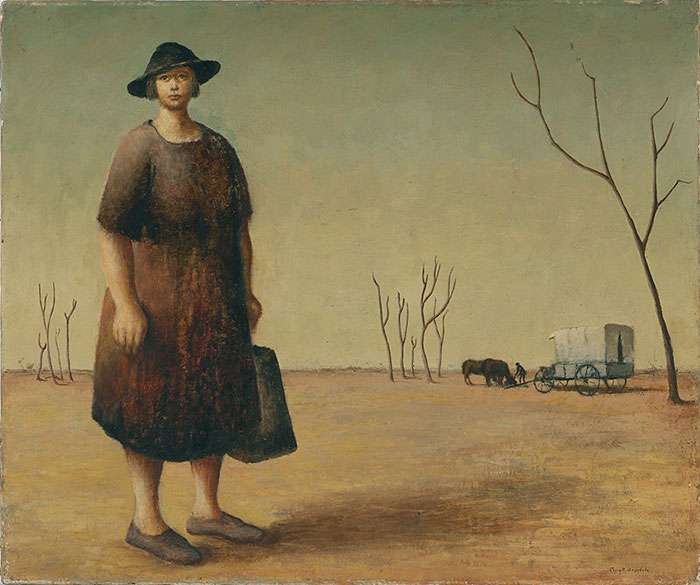
‘The Drover’s Wife’ is a short story that was first published in The Bulletin in 1892. It follows the endurance of an Australian mother who must live through her husband’s absences. He is a drover — a person who drives livestock, often over long distances — and, therefore, must be away from home for prolonged periods. His wife, who remains unnamed throughout the story, must raise her four children alone whilst also surviving the harsh rural landscape in which she lives. She recounts the many battles she has fought in her lifetime, but the present tense of the story focuses on her altercation with a deadly snake.
This classic piece of Australian literature is considered to belong to the genres of drama and domestic fiction. This makes sense, given its high-energy exploration of everyday life. Further, the story was published during a time when there was a widespread desire to establish a distinctly Australian culture. Therefore, it is from so-called realistic stories like Lawson’s that an imagined narrative of resilient countrymen and women arose. This story, in particular, is often read and discussed in terms of its allegedly hyper realistic depiction of settler-Australians and rural Australia.
Yet, despite its realist storytelling and distinct lack of ancient ruins or supernatural figures, ‘The Drover’s Wife’ has more in common with the Gothic genre than first appears. Settlement in Australia began during the eighteenth and nineteenth centuries; this coincides with the rise of the Gothic genre and the publishing of this story. 2 Given this context, a variety of Gothic conventions and themes can be discerned within Lawson’s writing. Thus, it can be argued that ‘The Drover’s Wife’ is an inherently Gothic tale.
Isolation and the Australian Landscape
The story worlds of Gothic fiction often include extreme and disconcerting isolation. Rural Australia, then, provides a setting ripe for the Gothic. From the introductory sentences of Lawson’s story, the geographical isolation of the protagonist’s home is emphasised. Stated as neither positive or negative, the scene is described as such:
“Bush all round—bush with no horizon, for the country is flat. No ranges in the distance. The bush consists of stunted, rotten native apple-trees. No undergrowth. Nothing to relieve the eye save the darker green of a few she-oaks which are sighing above the narrow, almost waterless creek. Nineteen miles to the nearest sign of civilization—a shanty on the main road.”
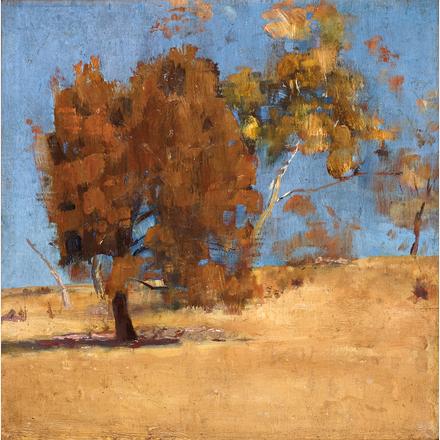
Adding further evidence that the drover’s wife lives cut-off from others, the story states, “the drover, an ex-squatter, is away with sheep. His wife and children are left here alone.” Therefore, not only must she endure physical isolation, she is also forced to live in solitude, aside from the company of her children. This estrangement from her loved one is described sadly, as the protagonist reflects that her husband “may forget sometimes that he is married.” Describing the setting in this way is foreboding; though the isolation might not pose an immediate risk, it does heighten the threats that the wife faces throughout the story.
Within the Gothic genre, isolation can be used to emphasise the vulnerability and helplessness of characters. This is as the word “isolation” carries connotations of an unwanted detachment from others. Settings typically associated with the Gothic genre, like castles or monasteries, present the frightening possibility of being forced into isolation in secret spaces. 3 Rural Australia in the 1800s posed the same perceived threat. This is due to its vast expanses and lack of population, evident in Lawson’s description of the wife’s home. Put simply there is “not a soul to meet” in this setting. Therefore, if a threat is posed, there is also “not a soul” to provide assistance.
Though she is not locked away in a tower, the protagonist is unable to escape her environment and, thus, her isolation is strictly enforced. True to Gothic convention, this story presents the common situation of a defenceless woman unable to flee her confinement. 4 Her only rescuer is her absent husband, yet even he is not capable of saving her. The story states, “if he had the means he would take her to the city and keep her there like a princess.” He cannot take her to the city though — which is presented as a preferred alternative to rurality — and she cannot take herself there either. In this way, the drover’s wife has much in common with the confined women of Gothic classics.
An Environmental Monster
Isolation on its own is depicted by Lawson as neutral. However, the antagonist of the story — the Australian environment — turns this isolation into something menacing. Within Gothic stories, there is usually a frightening person or thing to be overcome. This is often in the form of a monster; Frankenstein and Dracula are two famous examples of Gothic monsters. These threatening figures — whether real or not — must be suppressed or eradicated entirely for the story to reach its resolution. Within ‘The Drover’s Wife,’ the monster is the Australian environment.
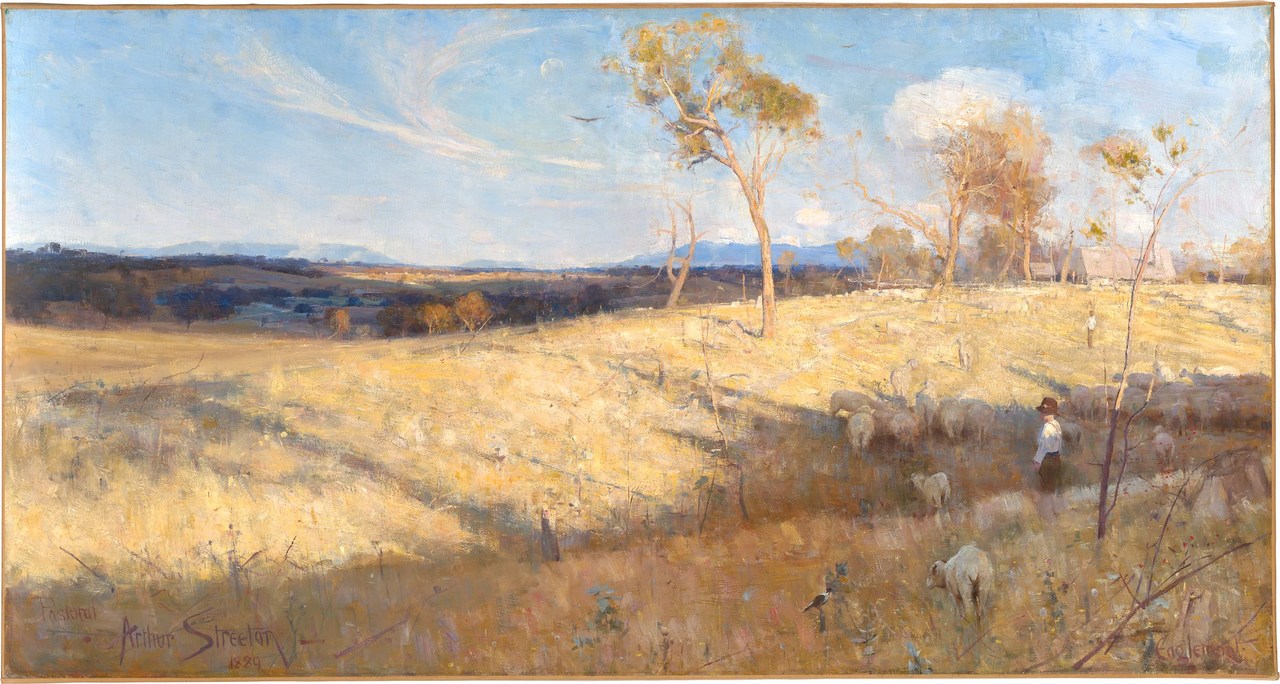
The main concern of the drover’s wife is a snake that has found its way on to her property. From the moment it is spotted, it unsettles the entire family, including the dog named Alligator. From this point onwards, the fact of there being a snake present influences the actions of the wife. She must take this imminent threat into consideration with every move she makes:
“The children must be brought inside. She will not take them into the house, for she knows the snake is there, and may at any moment come up through a crack in the rough slab floor; so she carries several armfuls of firewood into the kitchen, and then takes the children there.”
The kitchen is separate from the main house. It has an “earthen” or “ground floor” as described by the protagonist. Therefore, this is a safer place for the family to take shelter. She makes her children sleep on the kitchen table for extra protection. While they sleep, the mother stays awake all night keeping watch. Settled for the evening, “she has an eye on the corner, and a green sapling club laid in readiness on the dresser by her side.”
Australia is known for its deadly snakes, with hundreds of species of the animal inhabiting the country. The story does not specify what kind of snake it is though, other than being coloured black. Given the distinct possibility that it could be highly venomous, it makes sense that the wife would be wary of any snake. Indeed, it is acknowledged that she is more cautious than usual due to her nephew having been recently killed by a snake.
This snake causes the family great unease. The wife’s son, who is named Tommy, teases his younger sibling, showing the horror associated with snakes. He says that if bitten by the snake, “you’ll swell up, an’ smell, an’ turn red an’ green an’ blue all over till yer bust.” Thus, the wife stays awake all night watching out for it. She is unsettled and ready to attack, “whenever she hears a noise, she reaches for the stick.”
The story only reaches its resolution when the snake is killed. A violent death, the wife bludgeons the snake to death. Then, “she lifts the mangled reptile on the point of her stick, carries it to the fire, and throws it in; then piles on the wood and watches the snake burn.” The story ends shortly after, with the dog being calmed and the children soothed enough to go back to sleep.
This demonstrates how the story’s monster — the Australian landscape which includes its wildlife — causes great fear and anxiety. These feelings are a fundamental part of the Gothic tradition. Indeed, the genre often involves characters feeling supreme dread for the situations they may find themselves in. 5 This terror is pivotal to the genre, and the overwhelming presence of such a feeling within ‘The Drover’s Wife’ suggests that it is, perhaps inadvertently, Gothic in nature.
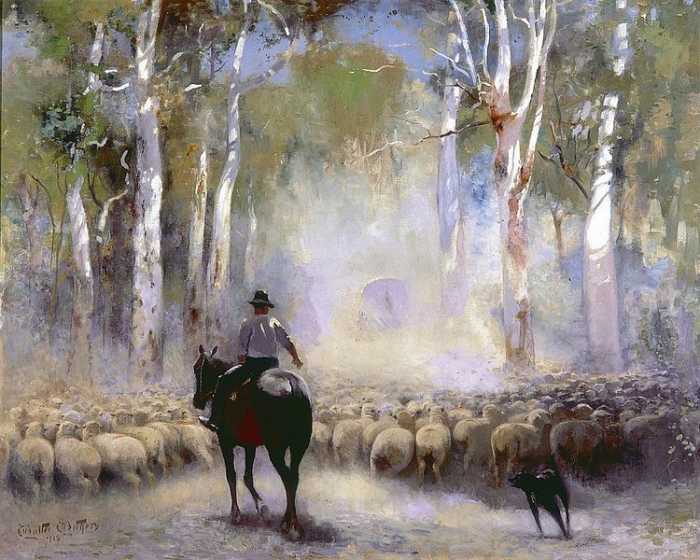
The snake is not the only part of the natural world that threatens the livelihood of the drover’s wife, though. Within the story she reflects upon two major events she lived through. The first was a bushfire; “the grass was long, and very dry, and the fire threatened to burn her out.” Much like with the snake, the wife’s response to this threat was active. She “beat out the flames with a green bough, till great drops of sooty perspiration stood out on her forehead and ran in streaks down her blackened arms.” With the assistance of bushmen who arrived “in the nick of time,” the fire was suppressed and her timber home was saved.
The same cannot be said for the flood she recalls surviving. The wife, once again, actively responded to this disaster. “She stood for hours in the drenching downpour, and dug an overflow gutter to save the dam across the creek.” Her efforts were ultimately unsuccessful, however, and she was forced to witness “the result of years of labour swept away.”
Other naturally occurring obstacles that threatened her livelihood include “a mad bullock that besieged the house for a day,” crows and eagles that frequently attack her chickens, and illnesses befalling her best cows. It is worth noting how each of these problems are exacerbated by her isolation. Potentially, they could have been better dealt with if she was not alone.
By listing these happenings, the author demonstrates that the natural environment has been an ongoing source of torment for the protagonist. Her living conditions have caused her great pain and anxiety, and it is implied that they will continue to do so in to the future. This snake might be dead but there will most likely be others. Interpreting the Australian land as a monster or villain supports a Gothic reading of Lawson’s story.
A Heroine in Need
The roles for women and men within Gothic tradition are often directly opposed. Women are the fainting damsels in need of saving; men are the gallant heroes who save them by defeating the monster. Though ‘The Drover’s Wife’ might be viewed as subversive in this regard — she does fight her own battles — the story maintains her womanly helplessness in few ways.
For each predicament the wife finds herself in, she has someone to help her through it. Her responses to danger are active, but they are never just her own. When she confronts the snake, she does so with the aid of the dog. He is able to pull it out from underneath the house. Had he not done so, the snake likely would have escaped again:
“He has the snake now, and tugs it out eighteen inches…Alligator gives another pull and he has the snake out—a black brute, five feet long. The head rises to dart about, but the dog has the enemy close to the neck. He is a big, heavy dog, but quick as a terrier. He shakes the snake as though he felt the original curse in common with mankind.”
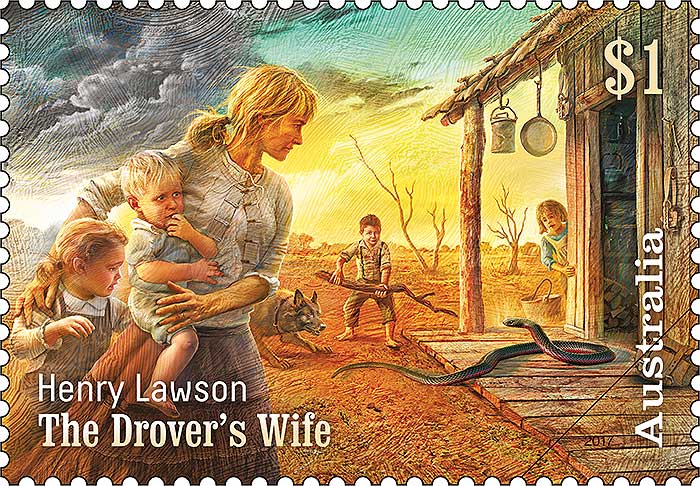
Similarly, when her home is threatened by a bushfire, it is not her tireless beating of the flames that ultimately saves the home. The story states plainly that “the fire would have mastered her but for four excited bushmen who arrived in the nick of time.” The story also briefly mentions that the drover’s brother supplies the drover’s wife with provisions once a month, essentially to keep the woman and children alive. Lawson explicitly depicts her reliance upon others in these instances. Uncoincidentally, her saviours are men.
It is when she is without assistance, then, that she is defeated. No aid arrived when the drover’s wife fought a flood, and thus, she could not prevent its destruction. This failure is directly attributed to her gender; “she could not save it. There are things that a bushwoman cannot do.” Her response to her failure is also noticeably emotional, “next morning the dam was broken, and her heart was nearly broken too.” This supports the depiction of her as a woman in need of saving, as it demonstrates her so-called feminine sensibility. This, put simply, is “emotional responsivity at the expense of reason.” 6
This trope is not specific to the Gothic genre, of course. Especially for nineteenth century literature, writing women as weak and lacking reason was commonplace. However, paired with the other conventions of the genre evident in the text, Lawson’s depiction of masculinity and femininity fits well within Gothic tradition. Ultimately, the wife will never escape the monster — the Australian landscape — unless her husband saves her by taking her away from it. Thus, the wife befits the description of a helpless Gothic heroine.
Mental Distress
The Gothic genre has always been concerned with exploring the human mind. This includes everything from how the mind can be altered, to the impacts of mental illness or ‘madness.’ 7 Gothic tales often explore the mental distress that accompanies the actual events occurring within the narrative. Indeed, terror itself — a feeling which is vital to the Gothic genre — involves great psychological suffering. This so-called madness is the part of the mind with which ‘The Drover’s Wife’ is concerned. It is never explicitly stated that the wife is suffering. However, the story contains several hints that suggest her mental health has declined.
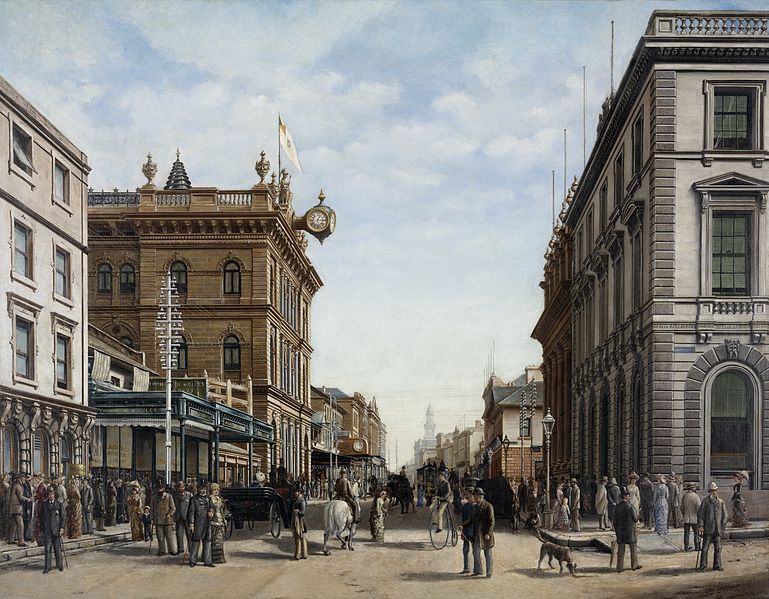
The wife’s feelings towards her established isolation and loneliness are the first indication of the state of her mental health. Her life is described as being monotonous; “all days are much the same to her.” Lawson’s further descriptions depict her living arrangements as “maddening”:
“This is because of the everlasting, maddening sameness of the stunted trees—that monotony which makes a man long to break away and travel as far as trains can go, and sail as far as ship can sail—and farther.”
The story still does not state that the wife is bothered by this, but paying close attention to the author’s language choices suggests otherwise. The third-person narrator says that “she seems contented with her lot.” On its own, this might suggest that she really is fine. However, when contrasted with the sentence before it which states definitively “she is glad when her husband returns,” the use of “seems” makes the statement questionable. The subtle difference allows readers to infer that she is, indeed, not content and potentially even unhappy.
More relevant to Gothic tradition, however, is that most of the story’s events take place within the mind and memory of the protagonist. Other than her scuffle with the snake, everything else that occurs is being re-lived by the wife. This implies that these memories weigh heavily on her mind. These memories come to her late at night, when she is sitting idly by the fire. Thus, one might assume that they return to her every time she is left alone with her thoughts. Furthermore, it only takes minor things to prompt her recall of these troubling events, “the rain will make the grass grow, and this reminds her how she fought a bush-fire once while her husband was away.” Within her own mind, her past is inescapable.
This ultimately takes its toll on her. Towards the end of the story, after she recollects the fire, the flood, dangerous animals, the death of her child, and being threatened by dangerous men, she breaks down and cries. Her dishevelled handkerchief, perhaps, symbolising her own emotional state:
“She is hurt now, and tears spring to her eyes as she sits down again by the table. She takes up a handkerchief to wipe the tears away, but pokes her eyes with her bare fingers instead. The handkerchief is full of holes, and she finds that she has put her thumb through one, and her forefinger through another.”
Some scholars note that this focus on the mind is reminiscent of Edgar Allan Poe’s writing. Within Poe’s Gothic texts, “fear is psychological, resulting from a haunted conscience, perverseness, and morbidity intensified by the environment.” 8 ‘The Drover’s Wife’ is befitting of this description due to its preoccupation with the protagonist’s psychological processes. Furthermore, the environment is paramount in creating intense fear. Lawson has been described as “Australia’s Edgar Allan Poe” for these similarities. 9 Lawson’s deliberate choice to write from the perspective of the wife’s memory casts doubt upon its alleged realism whilst promoting a Gothic interpretation.
Real World Anxiety
Finally, the imagined aspects of Gothic literature can often translate to real world fears. For example, the vampire figure has long been used to represent specific fears or anxieties. These anxieties differ depending on the story, as well as the story’s context. In fact, the Gothic genre often gets its power to unsettle and spook from this very insertion of the real world into its fictitious spaces. Continuing with the vampire example, Dracula does not frighten simply because he sucks blood; he is a representation of everything Victorian England feared at the time when Dracula was published.
‘The Drover’s Wife,’ and the fears felt by its protagonist, presents a fictitious account of the real concerns experienced by settler Australians. Alongside a confronting history of colonisation, Australia also has a complex environmental history. In particular, settlers lacked the knowledge necessary to maintain the Australian landscape as it was so vastly different from that which they were accustomed to in Europe. Indeed, many so-called natural disasters were caused by the mismanagement of the physical land. The result of this was often the destruction of livelihoods and even death. For settlers, the potential for the landscape to wreak havoc was widely feared.
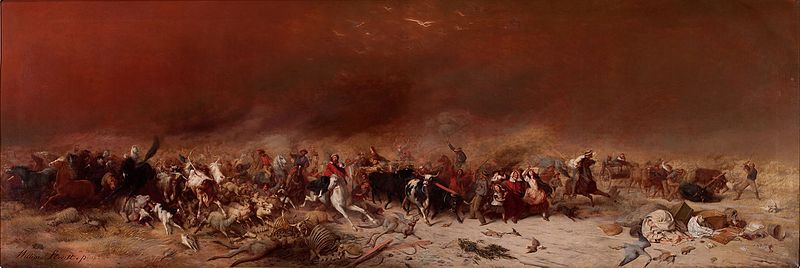
This fear was not unfounded though, and often the land did wreak havoc on settlers. Prior to Lawson’s story being published, in the mid-1800s, the Australian colonies underwent several catastrophic events. In 1851, the Black Thursday bushfires ravaged the Colony of Victoria. Surprisingly, only 12 people were killed despite a quarter of the colony’s physical land being burned. Thousands of cattle and one million sheep were estimated to have perished in the fire. 10 During the following year, a flood in the New South Wales town of Gundagai killed 89 of the town’s 250 residents. 11
For settlers, these events and others like them set a terrifying precedent, leaving them in a state of dread. There was no way of knowing if or when such events would occur again. Thus, it is this real world anxiety that finds its way into ‘The Drover’s Wife’ in true Gothic style. Rather than leave it open to interpretation, like with vampires, Lawson makes this anxiety explicit. It is in this regard that the story is considered to be realistic fiction. However, the focus on very real anxieties is also befitting of the Gothic.
Natural disasters are not the only fear present in Lawson’s story, however. The so-called colonial experience, as some scholars have argued, fits well within the literary tradition of the Gothic. 12 Key aspects of the genre — dislocation, unsettling scenarios, and being surrounded by the unfamiliar — are similar to what settlers experienced upon migrating to the Australian colonies. The often bleak depiction of the protagonist’s life provides an account of that fear being realised.
Inserting the real world into a story to elicit undesirable feelings within the readership is something the Gothic has always done well. Lawson’s ability to do the same within ‘The Drover’s Wife’ means that it can be interpreted as belonging to this genre. The anxieties of the story’s protagonist were likely supremely relatable for those who were reading at the time of publication; giving it the power to exacerbate pre-existing fears.
‘The Drover’s Wife’ is unlikely to find itself included on the syllabus of any Gothic literature class, nor included in an anthology of Australian Gothic stories. In fact, other works by Lawson, such as his story ‘The Bush Undertaker’, usually receive this treatment instead. ‘The Drover’s Wife’ will continue to be studied and celebrated for its depiction of an allegedly realistic settler-Australia alone.
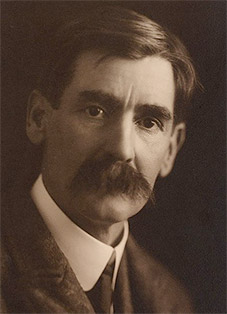
Ultimately though, ‘The Drover’s Wife’ is a work of Australian Gothic fiction and should be read as such. This is evident in the author’s use of themes and tropes that are integral to the genre. The similarities between Lawson’s story and many canonical Gothic classics — both Australian and international — are numerous. Indeed, the fact that this story is inherently Gothic, whilst still being perceived as realistic, offers insight into the lived experiences of settler-Australians.
Thus, perhaps, it is better to not think of this story as either one or the other; it is not just Gothic fiction and it is not just domestic fiction. Given the context of the story’s publication — when settlement was new and daunting and when natural disasters were frequent and unprecedented — this story is potentially a combination of both genres. For settlers, it is likely that their reality would have felt a little Gothic. Reading ‘The Drover’s Wife’ as a Gothic text, then, contributes to understanding how Australian settlers lived and the emotional turmoil that may have accompanied their lives.
Works Cited
- Lawson H (1892) ‘The Drover’s Wife’, While the Billy Boils [eBook], http://www.telelib.com/authors/L/LawsonHenry/prose/billyboils_2/droverswife.html. ↩
- Turcotte G (1998) ‘Australian Gothic’, https://ro.uow.edu.au/artspapers/60 ↩
- Wright A (2020) ‘Gothic and the Hermeneutics of Isolation’, fifteeneightyfour, http://www.cambridgeblog.org/2020/06/gothic-and-the-hermeneutics-of-isolation/. ↩
- Ibid. ↩
- Afrougheh S, Abouheidari R and Safari H (2013) ‘Terror and the Notification of Anxiety in Postmodern Gothic’, Procedia, 70:1389-1393, https://doi.org/10.1016/j.sbspro.2013.01.201. ↩
- Knowles C (n.d.) ‘Feminism and the Gothic: A Brief History’, Gothic Research [webpage], https://library.unimelb.edu.au/exhibitions/dark-imaginings/gothicresearch/feminism-and-the-gothic-a-brief-history. ↩
- Fall W (n.d.) ‘Glossary of the Gothic: Workings of the Mind’, Marquette University [webpage], https://epublications.marquette.edu/gothic_workingsmind/. ↩
- Ramakrishna D (2008) ‘The Australian Gothic and Edgar Allan Poe’, The Edgar Allan Poe Review, 9(1):49-54, https://www.jstor.org/stable/41506282. ↩
- Ibid. ↩
- National Museum Australia (n.d.) ‘Black Thursday Bushfires’, National Museum Australia [webpage], https://www.nma.gov.au/defining-moments/resources/black-thursday-bushfires. ↩
- SBS News (2015) ‘Australia’s worst natural disasters’, SBS News [webpage], https://www.sbs.com.au/news/australia-s-worst-natural-disasters. ↩
- Turcotte G (1998) ‘Australian Gothic’. ↩
What do you think? Leave a comment.











Thank you for introducing me to this work! I had never heard of it before reading your article. Yes, I can see some parallels between this and gothic fiction, especially when it comes to a desolate and terror-filled landscape one must confront alone.
It is interesting to think about how culture influences the way that writers use landscape in fiction. For instance, when most people think of Gothic stories they probably think of castles and other typically European locations, but Australia presumably has completely different scenery from most European countries. At the same time, as you point out, there are things about the Australian environment that could create tension, which an Australian author could exploit.
I read the story directly after reading your article. I found it well written and entertaining. Thank you for introducing us to it.
Aussie novel at its finest.
One of the most touching and astounding pieces of Australian literature I have ever read.
The lesson we learn is tough times can be a lot tougher.
What I found most interesting is the narrative structure of this short story. Allows us as readers to delve into the innermost thoughts of drover’s wife. Her loneliness and diminished hopes are elucidated and mimic memories that she must relive.
That is one of my favourite aspects of this story, I agree! It also raises issues of her potentially being an unreliable narrator which is an idea that would be interesting to explore.
I liked the way in which the woman is nostalgic about the past and still indulges in some of the things she enjoyed before getting married.
There is plenty of symbolism and allegorical gestures in this short story, from the snake to the husbands pants. Classic.
Lovely gothic atmosphere in this story.
Should be included in academia. Highly recommended as a read-aloud for primary and early secondary children as a further discussion starter on Australian history.
I remember this story clearly from my school days, mainly because I got told off for reading it too fast… my response – tell everyone to listen quicker…
I think ‘conversation starter’ is absolutely the right phrase to use here. In a period of Australian history that is often synonymous with white masculinity, this story offers the perspective of someone outside of that grand narrative. Though I think it need be acknowledged that it is not without its problems.
Themes as relevant today as when they were depicted in the novel.
There is a great rewrite of this short story by Leah Purcell. It is also called “The Drover’s Wife”. This time, the threat is a man. Highly recommended if you haven’t read it already.
Yes! A wise, thoughtful and a timely contribution to a wider more inclusive shared past story.
Harrowing representation of life for women and Indigenous Australians!
While Lawson’s version is the foundation, Purcell’s version definitely speaks more truth about Australian history than the original. Excellent and on point depiction of Aboriginal Australian treatment in the colonial period.
Loved this book. It is a devastating and powerful re-imagining of the Henry Lawson story.
I was aware of Purcell’s adaptation but I have never read it, or looked into it really. Each of these comments have absolutely convinced me to go check it out though!
Very good novel. Doesn’t shy away from the horrors and truth of ‘settlement’.
I am currently exploring and enjoying some of the Australian classics and Henry Lawson is a beauty.
If you enjoy Lawson, Banjo Patterson is another author worth looking into (he’s the man pictured on the Australian $10 note).
I always feel nostalgic whenever I read Henry Lawson although my childhood was on a farm in a far more fertile area than the settings he generally used.
I am in line with historian John Hirst that the Drover’s Wife carries the explicit message that pioneer women were sacrificial heroines because they did not belong — that the bush was no place for a (white) woman. There was little room in the sacred rural myth for women who thrived in their life beyond the townships and who were successful in their agricultural enterprises. In the United States, the early settlers are depicted as families — men, women and children travelling west in covered wagons. In Australia, the lone male battler captured centre stage. But you know very well that I think that in the history of Australian farming, women very much were the real story.
I cited Hirst in my dissertation for his advocacy of a Pioneer myth, which began in earnest with the writing of Miles Franklin/Brent of Bin Bin and Steele Rudd. But the rightwing politics of men/mateship in the bush which leads directly to Brave Anzacs etc has proved overwhelming.
My brief stint studying Australian environmental history during my undergrad degree touched upon some of this theory. I think I tend to agree with this also.
An observation. The dog plays an important role in keeping the family safe and the family also seemed to be attached to him.
I often find myself uninterested in depictions of the Australian bushland, and literature set in colonial times. But this one is written artistically, and resonates with me as an Australian even today.
Good analysis. I could never write anything as good as this.
I appreciate this greatly! But nonsense, practise is all it takes. 🙂
I’m interested in settler colonialism in Australia and New Zealand. This settler narrative gives us an insight into the struggles of the settler community thus unsettling the colonizer and the colonized binary.
Great story about the unrealised heroics of a mother.
Read this in school long time ago. Not something that spoke to me or that I would spend my time reading again.
Interesting how the Drover’s Wife, and variations upon the theme, ‘suddenly’ seems to be everywhere. I think it’s a good thing but I wonder why? Is she the only fictional Australian woman who readily springs to mind?
I didn’t realise that it was ‘everywhere’ as you say. But I think it further emphasises the point that Australian colonialism was mythologised as inherently masculine. The fact that I, and many others who have not studied this period extensively, might only be able to name this one fictional woman demonstrates how few they were within popular culture.
The premise sounds so strong. I should begin by reading the short story I think…
I would see the play of the Drover’s Wife if I had the chance.
Stunning, dark, to go on my book club list! 😉
It is a very brief story and a quick read. Hope you enjoy!
I am not from Australia, but I can see the impact the original story has had on the Aussie psyche.
Can’t help but be moved reading and walking in the shoes of the character as she experiences life on the frontier in all its unpredictability and harshness.
I like Murray Bail’s version of the short story.
Yet another adaptation of the story that I will need to check out!
Fantastic. A great short story about a woman surviving the harsh Australian bush whilst her husband is away – and thereby defining her as a woman in her own right and not merely “the drover’s wife”.
Enjoyed reading about this story about her commitment and sacrifice.
I remember reading this in high school. Very good character. She evokes admiration and respect from; she is really a phenomenal woman, with extraordinary courage and strong will power that keeps her children alive.
Love a female character with such fortitude.
Definitely an interesting read!
A must for Australian students – it shows us the stuff we are made of.
She is woman against nature – strong, capeable, resilient – unhappy but resigned to her lot in life.
An absolute classic.
Such amazing women from an era gone
Really interesting read! I think the Australian landscape has always captivated artists of all types as a place of wonder, mystery, awe and forebode. It most certainly functions well as an element of fear in the Gothic tradition.
A thought that I had: The Drover’s Wife could be a work that has both Gothic and Realist elements as the two don’t have to be mutually exclusive. Indeed, given when it was written, it quite easily can have elements of both, as it was written roughly in the transition from Romanticism (of which Gothic is a subset) to Realism. I say this because the literary periods of the United States, just at a cursory glance track fairly closely to the periods of Australia. If this holds true, Henry Lawson serves as a transitional literary figure, just as Walt Whitman did in America, and in similar ways. Just some thoughts.
I wrote a poem as a tribute to Henry Lawson simply called ‘Lawson’ which I am happy to forward to you if you like…let me know..regards
Chris Battams.
‘The status of the aborigine in the writing of Henry Lawson. ‘A reconsideration.’
Lee, Christopher (2002) The status of the Aborigine in the writing of Henry Lawson: a reconsideration. The La Trobe Journal (70). pp. 74-83. ISSN 1441-3760
“Henry Lawson’s treatment of racial difference has drawn significant criticism over the last 30 years or so as successive generations of critics have sought to expose the racist assumptions embedded in some of this country’s most cherished myths. WH Peterson’s ‘Henry Lawson among the Maoris’ (1968) and Humphrey McQueen’s ‘A New Britannia’ (1970) probe the intelligent and sensitive Australian writers failure to extend his sympathies to other colours and other cultures. In more recent times journalists and academics have revisited the subject by interpreting the Renaissance of racial politics in this country as a return to the older monocultural Australia, for which they imagine Henry Lawson as its standard bearer.”
Great discussion thank you! There is some really interesting applied and deliberate uses of Australian Gothic that comment in fascinating ways on our canon.